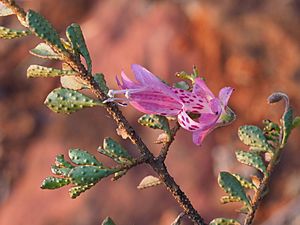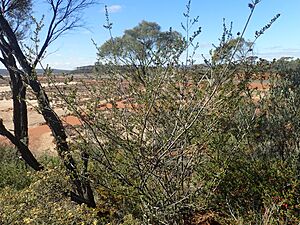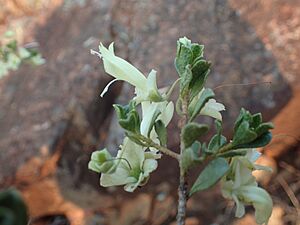Purple eremophila facts for kids
Quick facts for kids Purple eremophila |
|
|---|---|
 |
|
| Eremophila purpurascens leaves and flowers | |
| Conservation status | |
| Scientific classification | |
| Genus: |
Eremophila (plant)
|
| Species: |
purpurascens
|
The Eremophila purpurascens, also known as purple eremophila, is a beautiful flowering plant. It belongs to the figwort family, called Scrophulariaceae. This plant is special because it is endemic to Western Australia, meaning it naturally grows only there. It's a tall, bushy plant with bumpy leaves and pretty pink to red flowers that often have spots.
Contents
What Does Purple Eremophila Look Like?
The purple eremophila is a tall, bushy shrub with many branches that grow in different directions. It can grow up to about 1.5 metres (5 feet) tall. Many of its branches start right from the ground. If you crush its leaves, they smell a bit like camphor.
The branches have old leaf bases that stick out, and they often feel sticky because of a natural resin. The leaves are usually grouped together at the ends of the branches. They are thick, a bit fleshy, and shaped like an egg or a spoon. They are usually about 7.5 to 12 millimetres (0.3 to 0.5 inches) long and 3 to 6 millimetres (0.1 to 0.2 inches) wide. These leaves also have noticeable bumpy parts called glands.
Flowers and Fruits
The flowers usually grow one by one where the leaves meet the stem. They sit on S-shaped, hairy stalks that are about 10 to 25 millimetres (0.4 to 1 inch) long. Each flower has five green and pinkish-purple sepals (leaf-like parts that protect the bud). These sepals are broadly egg-shaped and about 8 to 11 millimetres (0.3 to 0.4 inches) long.
The petals are about 22 to 30 millimetres (0.9 to 1.2 inches) long and are joined at the bottom to form a tube. When the flower is a bud, it's yellow with purple spots. But when it opens, the petal tube becomes light pinkish-purple with darker purple spots on the outside. The inside of the tube is yellow. The four stamens (the parts that produce pollen) stick out a little from the end of the petal tube.
Purple eremophila flowers from August to October. After the flowers, it produces dry, cone-shaped fruits that are about 4 millimetres (0.2 inches) long and black.

How Purple Eremophila Got Its Name
This plant was first officially described by a scientist named Robert Chinnock in 1979. He published his description in a scientific journal.
The second part of its scientific name, purpurascens, comes from two Latin words. Purpureus means "purple," and the ending -escens means "becoming." This name refers to the sepals of the flower, which become more purplish as they get older.
Where Does Purple Eremophila Grow?
Purple eremophila is found on rocky hills near a town called Norseman, Western Australia. This area is part of a larger natural region known as Coolgardie.
Protecting Purple Eremophila
The Western Australian Government's Department of Parks and Wildlife has listed Eremophila purpurascens as "Priority Three". This means that not much is known about this plant, and it only grows in a few places. However, it is not currently in immediate danger of disappearing. It's important to keep an eye on these plants to make sure they stay safe!
Growing Purple Eremophila in Gardens
People like to grow purple eremophila in their gardens because of its thick, heart-shaped leaves and its pretty pinkish-purple flowers. It's quite easy to grow new plants from cuttings (small pieces of the plant).
This plant grows well in different types of soil, even clay. It's a tough garden plant that doesn't need much watering, even during long dry periods. It can also handle frost very well.



